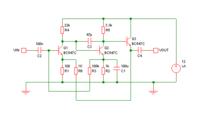diaz080
Member level 4

- Joined
- Oct 3, 2012
- Messages
- 73
- Helped
- 0
- Reputation
- 0
- Reaction score
- 0
- Trophy points
- 1,286
- Activity points
- 1,714
For understanding the concept of phase margin i need to design bjt amplifier with poor phase margin (oscillatory output) and then do compensation to make the amplifier stable. can anyone suggest me the method for doing this.





